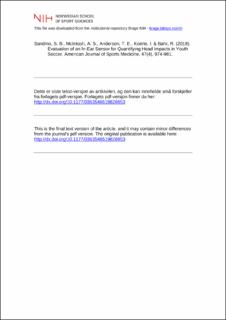| dc.description.abstract | Background: Wearable sensor systems have the potential to quantify head kinematic responses of head impacts in soccer. However, on-field use of sensors (eg, accelerometers) remains challenging, owing to poor coupling to the head and difficulties discriminating low-severity direct head impacts from inertial loading of the head from human movements, such as jumping and landing. Purpose: To test the validity of an in-ear sensor for quantifying head impacts in youth soccer. Study Design: Descriptive laboratory study. Methods: First, the sensor was mounted to a Hybrid III headform and impacted with a linear impactor or a soccer ball. Peak linear acceleration (PLA), peak rotational acceleration (PRA), and peak rotational velocity (PRV) were obtained from both systems; random and systematic errors were calculated with Hybrid III as reference. Then, 6 youth soccer players wore sensors and performed a structured training protocol, including heading and nonheading exercises; they also completed 2 regular soccer sessions. For each accelerative event recorded, PLA, PRA, and PRV outputs were compared with video recordings. Receiver operating characteristic curves were used to determine the sensor’s discriminatory capacity in both on-field settings, establishing cutoff values for predicting outcomes. Results: For the laboratory tests, the random error was 11% for PLA, 20% for PRA, and 5% for PRV; the systematic error was 11%, 19%, and 5%, respectively. For the structured training protocol, heading events resulted in higher absolute values (PLA = 15.6g 6 11.8g) than nonheading events (PLA = 4.6g 6 1.2g); the area under the curve was 0.98 for PLA. In regular training sessions, the area under the curve was .0.99 for PLA. A 9g cutoff value yielded a positive predictive value of 100% in the structured training protocol versus 65% in the regular soccer sessions. Conclusion: The in-ear sensor displayed considerable random error and substantially overestimated head impact exposure. Despite the sensor’s excellent on-field accuracy for discriminating headings from other accelerative events in youth soccer, absolute values must be interpreted with caution, and there is a need for secondary means of verification (eg, video analysis) in real-life settings. | en_US |
